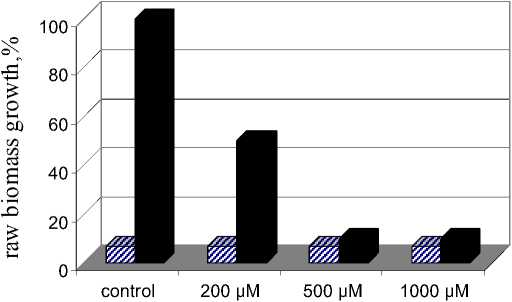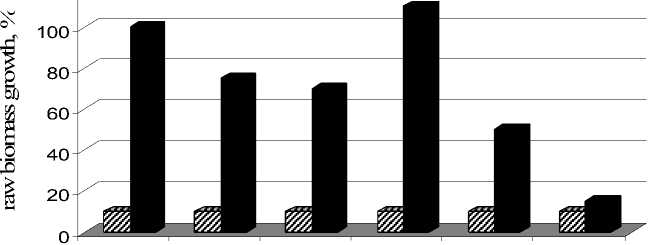The development of biotechnological approaches for decontamination of heavy metal pollution
Автор: Zhangalina E.D., Makazhanova H.
Журнал: Вестник Алматинского технологического университета @vestnik-atu
Рубрика: Естественные науки
Статья в выпуске: 1 (91), 2012 года.
Бесплатный доступ
In the course of experiments developed cell selection and received promising alfalfa cell lines thatcan be recommended as source material for plantgipperakkumulator of heavy metals.
Alfalfa, callusogenesis, somatic embryogenesis, cell selection, phytoremediation, heavy metal, copper, cadmium
Короткий адрес: https://sciup.org/140204939
IDR: 140204939 | УДК: 573.086.83:633/635
Текст научной статьи The development of biotechnological approaches for decontamination of heavy metal pollution
Негізгі сөздер: жоңышқа, каллусогенез, соматикалық эмбриогенез, клеткалық селекция, фиторемедиация, ауыр металдар, мыс, кадмий.
Introduction. Biotechnology is one of the main directions of scientific and technical progress whichhave playa key role in the economic development of human society. Now appears and expands biotechnology direction associated with the environmental focus. Over the past decades, continuous level of human impact on the natural environment, therefore all the more urgent becomes the problem of pollution of the biosphere in toxic compounds, including heavy metals (HM). Human economic activity, i.e. the burning of liquid and solid fuels, metal-smelting production, the dumping of sewage, soil chemicals including fertilizers polluting HM all components of the environment.
Among currently known technologies to clean up soil phytoremediation technology is the most promising, which is based on the ability of plants to accumulate in the cells of roots, stems and leaves the ions of heavy metals [1, 2]. Development the phytoreme-diation technology involve using biotech-nological approaches, in particular cell selection [3, 4, 5] and genetic engineering [6] for received plant-regenerants with gipper-accumulator ability of heavy metals.
This problem is especially important for Kazakhstan because the industrial complexes of our Republic built in regions with fertile soils and open sources of water for irrigation. However, the introduction of the environmental technology in Kazakhstan is largely due to the need to find plants-gipperaccumulatorof heavy metals in our environmental conditions. The idea of using plants to clean up soil from pollution is based on the existence of naturally occurring wild plants-giperaccumulatorHM, although the majority of known giperaccumulator have low production of bio mass and their commercial not profitable use for phytore-mediation. In this regard, the wild species are very promising in alfalfa phytoreme-diation technology because they have a high biomass productivity, improve soil fertility and rich free amino acids, proteins with low molecular mass and organic acids, which can bind the heavy metals.
Materials and methods.The object of research was wild species alfalfa - Medicago falcate which has the most extensive areal distribution on the territory of Russia and Kazakhstan among wild species. Medicago falcate samples was characterized by high winter, droughtand disease resistance, and very important as source material for cell selection. The callusogenesis was studied on Uchimya-Murashige (UM) media containing 2 mg/l 2,4-D and 0,25 mg/l kinetin and different concentration of copper and cadmiumions. Petiolsof 10-14 days aceptic plants were used as explants, The callusogenesis were assessed on two factors: the frequency and intensity. Suspension culture received from callus. After 18-20 day cultivation callus carried in liquid medium containing 2 mg/l 2.4-D and 0.25 mg/l kinetin. Cultivation of callus and cell suspensions carried out at a temperature of 23 ± 2° C, covering 1500-2000 Lux, 16-hour fotoperiode, relative humidity 55-60%.
The growth of cell suspension culture were evaluated for increasingthe raw biomass of cells. As a selective factor used CuSO4 x 5H2O in concentrations 50 мM and -1000мMand CdSO4 in concentrations 1-200 мM. To obtain callus, tolerant to copper and cadmium ions explants cultivated on nutrition medium contains a selective factor for induction callusogenesis during 28 days. Suspension culture was received by cultivation callus in liquid media. Cell selection for resistance to high concentrations of HM conducted by direct selection stage. Suspension in the presence of a selective factor was cultured during 30 days, then filtered and carried on UM medium, containing 0,05 mg/l NAA and 0,5 mg/l BAP for induction the somatic embryogenesis. Used as a control without selective breeding. Maturation, development and rooting the somatic embrio-ids were on Blaydes and Shenk-Hildebrandt medium without growth regulators.
Results and discussions. On the first stage was obtained the callus culture resistant to Cu++ and Cd++ ions by cultivation the explants on the nutrition medium, containing the different concentrations of selective factor. In the first series of experiments the concentration of Cu++ions was 50 мM, 100 мM, 200 мM, and Cd++ ions -10 мM, 25 мM, 50 мM, 100 мM and 200 мM. As a result of the experiments it has been shown that copper ions in relatively low concentrations (50 мM) stimulated and high concentrations (100 мM, 200 мM) inhibited the callus growth. Cadmium ions have a toxic effect on alfalfa callus culture and concentrations 50 мM, 100 мM, and 200 мM – proved to be lethal. In the second series the concentration of cadmium ion were reduced to 1 мM, 2,5мM, 5 мM, 10 мM, 20 мM. Callus induction was at all levels of selective factors. It was found that there was some correlation between the type of callus (i.e. between morphological characteristics-colour, consistence) and the concentration of Cu++ and Cd++ ions. As a result of cultivation was allocated the three types of callus. In control was formed white-yellow, granulate, containing middle water, non morphogenic callus. At low concentrations of HM (Cu++ ions - 50 мM and Cd++ ions - 1 мM, 2.5 мM, 5 мM) was formed white-yellow, loose, containing little waterembryogenic callus. At high concentrations of copper and cadmium ions was light yellow, very dense, containing little water callus. Concentration of cadmium ions 5 мM stimulated the callusogenesis, and on 10 мM and 20 мM the callusogenesis frequency was very low (table 1).
Table 1 - Effect of copper and cadmium ions on the callusogenesis frequency of Medicagofalcata
|
Selection factor |
Concentration мM |
Callusogenesis frequency, % |
Morphological callus characterization |
|
1 |
2 |
3 |
4 |
|
Cu++ |
control |
87,4±3,4 |
white-yellow, granulate, containing middle water, non morphogenic |
|
50 |
100 |
white-yellow, loose, containing little waterembryogenic |
|
|
100 |
65,2±3,3 |
light-yellow, very dense, containing little water |
|
|
200 |
45,3±2,8 |
light yellow, very dense, containing little water |
|
|
Cd++ |
control |
87,4±3,4 |
white-yellow, granulate, containing middle water, non morphogenic |
|
1 |
76,9±4,1 |
white-yellow, loose, containing little waterembryogenic |
|
|
2,5 |
70,7±3,2 |
white-yellow, loose, containing little waterembryogenic |
|
|
5 |
95,2±4,4 |
white-yellow, loose, containing little waterembryogenic |
|
|
10 |
27,4±1,9 |
light yellow, very dense, containing little water |
|
|
20 |
25,8±1,4 |
light yellow, very dense, containing little water |
The next step was cell selection for receiving the suspension culture of alfalfa resistant to high concentrations of Cu++ and Cd++ ions using the method of direct single selection. The cells are cultured in a wide range of concentrations of selective factor.
Concentration of selective factors was dependent on the sensitivity of the alfalfa cell lines. Using a wide range of concentrations of selective factor it was determine the minimum and maximum concentrations of HM that stops the reproduction of cells, as well as concentration, inhibiting the cells growth on 50% (LD 50).
Growth of suspension culture in the presence of a selective factor evaluated for cell biomass growth. It was determined that LD 50 for Cu++ ions - 200 µM and Cd++ ions -10 мM (Figure 1,2).
As a result of cell selection were received the embryogenic alfalfa suspension culture resistant to copper (200 мM, 300 мM and 500 µM) and cadmium ions (10µM). To retrieve the cell lines resistant to higher concentrations of cadmium ions should be holding cell selection by a multi-stage selection process.
Test of resistance to various stress factors can be a regeneration of plants from cells or tissues through somatic embryogenesis or organogenesis and evaluation of plant-regenerants. Further studies were directed to the induction of somatic embryogenesis.
The cells of the suspension culture tolerant to different concentrations of copper ions cultivated on the nutrition medium with 0,5 mg/l BAP and 0,05 mg/l NAA. Nutrition medium for induction somatic embryods did not include the selective factor.Embriogenic ability assessed by number of embryoid from 30 ml of suspension culture.

concentration of copper ions и initial biomass ■ biomass after 30 days of cultivation
Figure 1 - Effect of copper ions on the raw biomass growth in cell suspension culture of Medicagofalcata.

control 1µМ 2,5 µМ 5 µМ 10 µМ 20 µМ concentration of cadmium ions
и initial biomass ■ biomass after 30 days of cultivation
Figure 2 - Effect of cadmium ions on the raw biomass growth in cell suspension culture of Medicagofalcate.
After 30 day cultivation the embrioid was calculated: in the control - 67, and in the presence of 50 мM, 100 мM, 200 мM, 300 мM and 500 мM copper ions, 44, 59, 80, 10 and 5 respectively. Embryoids were large in size and have a bright green color. Somatic embryoids maturated and developed on the Blaydes medium, containing 2 g/l yeast extract and 100 mg/l mesoinosit. Through 30-35 days the well developedembryoids rooted on Shenk-Hildebrandt medium without growth regulators.
The regeneration frequency of somatic embryoids derived from suspension culture resistant to various concentrations of copper ions varied from 70% to 84% and was slightly lower than in controls (90%).
As a result of experiments, the plant-regenerants resistant to 50 мM, 100 мM, 200 мM, 300 мM and 500 мM copper ions were obtained.
Part of the plant-regenerants was preserved in vitro, the others planted in growing vessels. Assessment of the stability characteristics of resistance to copper ions in plants-being carried out at the cellular level. To do this, the petiols of the plant-regene-rants resistant to various concentrations of the copper ions cultivated on callus induction medium without selective factor. Experi-ments have shown that the frequency of recallusogenesis on nutrition medium containing 50 мM, 100 мM 200 мM copper ions can be compared with control (88%) and was 95%, 80% and 78%, respectively. This shows the stability to ions tolerant in callus level. The cultivation petiols from plant-regenerantson nutrition medium containing 300 мM and 500 мM copper ions recallusogenesis rate was very low at 10% and 7% respectively.
Thus, through a cell breeding method of single selection available plants-regeneranta resistant to 50 мM, 100 мM and 200мM m copper ions. Further, our research will focus on improving the method of cell selection by multi-step selection for promising alfalfa lines resistant to higher concentrations of copper, cadmium and other heavy metals.
Список литературы The development of biotechnological approaches for decontamination of heavy metal pollution
- Shevyakova N.I., Madghugina YU.G., Iljina E.N., Kuznetsov Vl.V. Calamagrosti-sepigeiosL. Roth and Brassica napusL. are promising plant species for the phytoremediation of Ni-contaminated soils in Russia//Joint Annual Meeting -GSA, SSSA, ASA, CSSA, GCAGB. Abstracts.5-9 October. Houston. 2008.
- Naumova R.P. Development of biotech-nologies for industrial toxic wastes remediation/Abstracts of the XIV international conference «Microbial enzymes in biotechnology and medicine». -Kazan, 2009. -P. 28-29.
- Goncharuk E.A. Effect of cadmium on morphogenesis, the anatomy of the stem and the regeneration process of flax-flax from cell and tissue culture in vitro. PhD thesis Biol Sciences, 2000.
- Salva E.M. A biotechnological techni-ques plants wheat, tolerant to cadmium ions and their physiological characteristics. PhD thesis. Biol. Sciences, 2011.
- Gladkov E.A. Getting integrated pobego-nosnojpolevicy plant tolerance to heavy metals and methods of cell breeding to salinization Agricultural biology. -2009. -№6. -Р. 85-88.
- Postrigan B.N., Knyazev A., Kuluev B.R., Yakhin O., Chemeris A.V. Activity of synthetic psevdofitohelatinos gene in tobacco plants. PlantPhysiology. -V. 59. -№. 2. -2012. -Р. 303-308.


